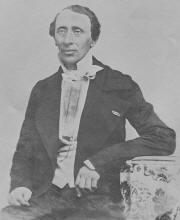|
His appearance against him
One of the reasons, though by no means the only reason why Andersen never married, may have been his unusual and to many of his contemporaries apparently unattractive appearance. He himself was always very conscious of the fact that his appearance was against him. Like his own ugly duckling he was" different". He was so tall, for instance, that in his student days he was known in Copenhagen as" lange Andersen"; the German author Chamisso in 1831 called him "der baumlange Däne". But what worried him most of all was that he was considered ugly. From Florence he wrote on April 9, 1834, to a young Danish friend:
I often think: if only I were handsome or rich and had a little office of some kind, then I would get married, I would work, eat and finally lie down in the churchyard what a pleasant life that would be; but since I am ugly and will always remain poor nobody will want to marry me, for that is what the girls look for, don't you know, and they are quite right. So I shall have to stand alone all my life as a poor thistle and be spat at because it happened to fall to my lot to have thorns.
, So I shall have to stand alone all my life as a poor thistle and be spat at because it happened to fall to my lot to have thorns'
The fact that Andersen himself was acutely aware of being ugly is also evident from the following story, told by William Bloch, a Danish author who knew the old Hans Christian Andersen very well:
One evening Ludvig Phister, a well-known Danish actor, met Andersen in the Royal Theatre and said to him: "My goodness, Herr Andersen, how pleased I am whenever I look at you; now you won't mind me telling you that as an adolescent you weren't very good-looking, but how pleasant to see the change that has taken place: now you are handsome." Andersen replied angrily: "How can you, whom I regard as a reasonable and intelligent person, think for one moment that I would believe what you are saying? I know perfectly well that I'm ugly rather than handsome, but you ought at least to respect in me that which is worthy of respect and not make fun of :t:ne to my face. Now you have ruined my evening. Thank you very much -I shall go home now."
Phister was not alone in going against the general verdict that Andersen was ugly. Kristian Zahrtmann, a Danish painter, writes in his memoirs about Andersen: "People ought to say that he had an impressive and good-looking appearance. But it had become customary to call him ugly, however, and so this was generally accepted. Later in life, when he got rid of his long false teeth, his head took on an extraordinarily beautiful shape, something for which the majority of people were blind." And in an article about Andersen Edvard Brandes, who knew him well as an old man, spoke of his "magnificient head".
Andersen was often photographed but rarely satisfied with the results. In Dresden he wrote in his diary on May 22, 1854: "Was driven over to be photographed, posed three times, looked like a peeled nutcracker." When in October 1864 he posed for H. V. Bissen, the Danish sculptor, the latter told him that the Lord had taken time to make his head more special than that of most others. Abroad he was sometimes laughed at by people who did not know him; during a visit to Gothenburg in July 1871 Andersen noted that " there were some simple people who seemed to be staring at me, didn't find me to their taste, laughed as I was laughed at in Granada. I was ill at ease thougb these people in Sweden looked like boiled potatoes."
William Bloch described the appearance of the old Andersen as he remembered him:
He was tall and thin, strange and bizarre in his movements and his carriage. His arms and legs were long and thin out of all proportion, his hands were broad and flat, and his feet of such gigantic dimensions it seemed reasonable that no one would ever have thought of stealing his goloshes.

Andersen c. 1850, daguerreotype.
His nose was in the so-called Roman style, but so disproportionately large that it seemed to dominate his whole face.
After one had left him it was definitely his nose one remembered most clearly, whereas his eyes, which were small and pale and well hidden in their sockets behind a couple of huge eyelids half covering them, did not leave any impression.
They were kind and friendly, but the fascinating interplay of light and shadows, the ever changing, expressive vividness that makes people's eyes a mirror of everything that goes on inside them, of that they had nothing. On the other hand there was both soul and beauty in his tall, open forehead and round his unusually well-shaped mouth. |